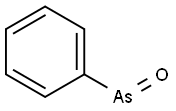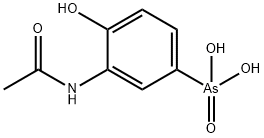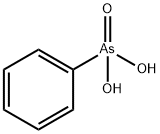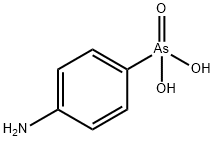Phenylarsine oxide
Synonym(s):Arzene;Oxophenylarsine;PAO;PAO, Oxophenylarsine, PTP Inhibitor IX, PDI Inhibitor II, Protein Disulfide Isomerase Inhibitor II;Phenylarsine Oxide - CAS 637-03-6 - Calbiochem
- CAS NO.:637-03-6
- Empirical Formula: C6H5AsO
- Molecular Weight: 168.02
- MDL number: MFCD00001990
- EINECS: 211-275-3
- SAFETY DATA SHEET (SDS)
- Update Date: 2025-01-27 09:38:02

What is Phenylarsine oxide?
Chemical properties
WHITE TO ALMOST WHITE CRYSTALS OR CRYST. POWDER
The Uses of Phenylarsine oxide
Phenylarsine oxide is used as a poultry coccidiostat in veterinary medicine. It is also used in a membrane-permeable protein tyrosine phosphatase inhibitor.
The Uses of Phenylarsine oxide
Pesticide.
What are the applications of Application
Phenylarsine oxide is a membrane-permeable PTPase inhibitor
Definition
ChEBI: An arsine oxide derived from phenylarsine.
General Description
Phenylarsine oxide (PhAsO4) is a bifunctional SH group chemical. It is hydrophobic in nature.
Biochem/physiol Actions
Phenylarsine oxide?(PAO) can reduce the motility and sustainability of Setaria cervi. It has the ability to stimulate cyclosporin A-sensitive transition in the presence of EGTA (ethylene glycol-bis(β-aminoethyl ether)-N,N,N′,N′-tetraacetic acid). It acts as a stimulator of mitochondrial ion fluxes.
Safety Profile
Poison by intravenous and intraperitoneal routes. When heated to decomposition it emits toxic fumes of As. See also ARSENIC COMPOUNDS
Properties of Phenylarsine oxide
| Melting point: | 145-148 °C |
| storage temp. | Poison room |
| solubility | DMSO: 50 mg/mL |
| form | powder |
| color | white to yellow |
| Water Solubility | Soluble in dimethyl sulfoxide, chloroform, benzene, ether, ethanol, 50:50 dimethyl sulfoxide:1 M hydrochloric acid (3.0 mg/ml) and toluene. Insoluble in water. |
| Merck | 14,6949 |
| BRN | 2935227 |
| Stability: | Stable. |
| CAS DataBase Reference | 637-03-6(CAS DataBase Reference) |
| EPA Substance Registry System | Oxophenylarsine (637-03-6) |
Safety information for Phenylarsine oxide
| Signal word | Danger |
| Pictogram(s) |
 Skull and Crossbones Acute Toxicity GHS06  Environment GHS09 |
| GHS Hazard Statements |
H410:Hazardous to the aquatic environment, long-term hazard |
| Precautionary Statement Codes |
P261:Avoid breathing dust/fume/gas/mist/vapours/spray. P264:Wash hands thoroughly after handling. P264:Wash skin thouroughly after handling. P270:Do not eat, drink or smoke when using this product. P273:Avoid release to the environment. P301+P310:IF SWALLOWED: Immediately call a POISON CENTER or doctor/physician. |
Computed Descriptors for Phenylarsine oxide
New Products
1-Amino-1-cyclohexanecarboxylic acid Cycloleucine 6-Bromo-3-iodo-1-methyl-1H-indazole 3-(2,4-Dimethoxybenzyl)dihydropyrimidine-2,4(1H,3H)-dione 7-Bromo-1H-indazole ELECTROLYTIC IRON POWDER 2-Methyl-2-phenylpropyl acetate 1-Aminocyclobutanecarboxylic acid 1-(2-Ethoxyethyl)-2-(piperidin-4-yl)-1H-benzo[d]imidazole hydrochloride Decanonitrile tert-butyl 4-(1H-benzo[d]iMidazol-2-yl)piperidine-1-carboxylate 4-Ethylbenzylamine Methyl 5-bromo-2-chloro-3-nitrobenzoate N-(5-Amino-2-methylphenyl)acetamide 2-Chloro-3-nitropyridine 5-Bromo-2,3-dimethoxypyridine methyl 6-chloro-2-(chloromethyl)nicotinate 2-methoxy-4-methyl-5-nitro pyridine 2-iodo-5-bromo pyridine 2-amino-4-methyl-5-nitro pyridine 5-Fluoro-2-Oxindole methyl L-alaninate hydrochloride diethyl L-glutamate hydrochloride Ethyl tosylcarbamateRelated products of tetrahydrofuran








You may like
-
 Phenylarsine Oxide CAS 637-03-6View Details
Phenylarsine Oxide CAS 637-03-6View Details
637-03-6 -
 Phenylarsine oxide CAS 637-03-6View Details
Phenylarsine oxide CAS 637-03-6View Details
637-03-6 -
 Ethoxymethylenemalononitrile 99% HPLCView Details
Ethoxymethylenemalononitrile 99% HPLCView Details
123-06-8 -
 Diethyl Disulfide 99% HPLCView Details
Diethyl Disulfide 99% HPLCView Details
110-81-6 -
 6285-05-8. 1-(4-chlorophenyl) propan-1-one 98%View Details
6285-05-8. 1-(4-chlorophenyl) propan-1-one 98%View Details
6285-05-8. -
 4-chloro-3,5-dinitropyridine 98%View Details
4-chloro-3,5-dinitropyridine 98%View Details -
 401-95-6 99% HPLCView Details
401-95-6 99% HPLCView Details
401-95-6 -
 171663-13-1 tert-Butyl 3-bromobenzylcarbamate 98%View Details
171663-13-1 tert-Butyl 3-bromobenzylcarbamate 98%View Details
171663-13-1